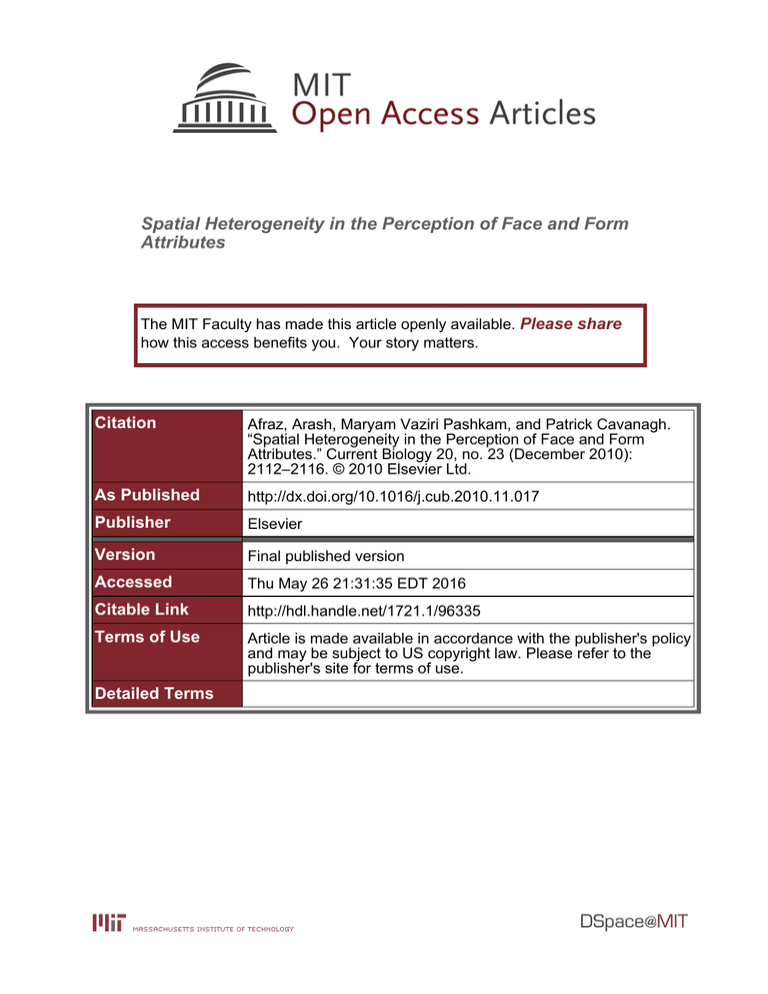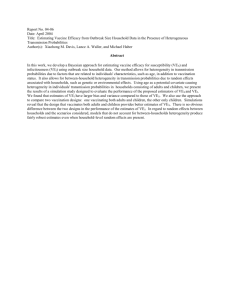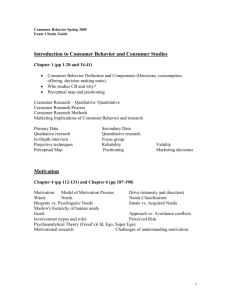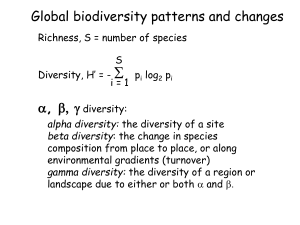
Spatial Heterogeneity in the Perception of Face and Form
Attributes
The MIT Faculty has made this article openly available. Please share
how this access benefits you. Your story matters.
Citation
Afraz, Arash, Maryam Vaziri Pashkam, and Patrick Cavanagh.
“Spatial Heterogeneity in the Perception of Face and Form
Attributes.” Current Biology 20, no. 23 (December 2010):
2112–2116. © 2010 Elsevier Ltd.
As Published
http://dx.doi.org/10.1016/j.cub.2010.11.017
Publisher
Elsevier
Version
Final published version
Accessed
Thu May 26 21:31:35 EDT 2016
Citable Link
http://hdl.handle.net/1721.1/96335
Terms of Use
Article is made available in accordance with the publisher's policy
and may be subject to US copyright law. Please refer to the
publisher's site for terms of use.
Detailed Terms
Current Biology 20, 2112–2116, December 7, 2010 ª2010 Elsevier Ltd All rights reserved
DOI 10.1016/j.cub.2010.11.017
Report
Spatial Heterogeneity
in the Perception
of Face and Form Attributes
Arash Afraz,1,2,4,* Maryam Vaziri Pashkam,1
and Patrick Cavanagh1,3
1Department of Psychology, Harvard University, 33 Kirkland
Street, Cambridge, MA 02138, USA
2McGovern Institute for Brain Research, Massachusetts
Institute of Technology, 77 Massachusetts Avenue,
Cambridge, MA 02189, USA
3Laboratoire Psychologie de la Perception, Université Paris
Descartes, 75006 Paris, France
Summary
The identity of an object is a fixed property, independent of
where it appears, and an effective visual system should
capture this invariance [1–3]. However, we now report that
the perceived gender of a face is strongly biased toward
male or female at different locations in the visual field. The
spatial pattern of these biases was distinctive and stable
for each individual. Identical neutral faces looked different
when they were presented simultaneously at locations
maximally biased to opposite genders. A similar effect was
observed for perceived age of faces. We measured the
magnitude of this perceptual heterogeneity for four other
visual judgments: perceived aspect ratio, orientation
discrimination, spatial-frequency discrimination, and color
discrimination. The effect was sizeable for the aspect ratio
task but substantially smaller for the other three tasks. We
also evaluated perceptual heterogeneity for facial gender
and orientation tasks at different spatial scales. Strong
heterogeneity was observed even for the orientation task
when tested at small scales. We suggest that perceptual
heterogeneity is a general property of visual perception
and results from undersampling of the visual signal at
spatial scales that are small relative to the size of the receptive fields associated with each visual attribute.
Results
We have measured the effect of retinal position on the perceptual appearance of objects for a number of object dimensions
and find substantial departures from invariance. The perceived
identity of an object should remain the same at different locations, but our first experiment showed a remarkable variation
in biases for male or female percepts as a function of location,
a local variation that offers insights into the scale and nature of
the underlying analyses. In this first experiment, subjects were
asked to identify the gender of faces that were chosen
randomly from a morphing spectrum between male and
female prototypes (FaceGen) based on 3D scans of real faces.
The stimuli (in all of the experiments) were flashed in one of the
eight possible locations at 3 eccentricity around a central
fixation point (see Supplemental Experimental Procedures
available online). The results were plotted separately for
*Correspondence: afraz@mit.edu
4This author has previously published as Seyed-Reza Afraz
each of the 11 subjects as the proportion of ‘‘female’’ response
(Figure 1). Data points were fitted with a logistic function to
calculate the point of subjective equality (PSE, ‘‘androgyny’’
in this case) where the face looked equally male and female
for each of the eight tested positions on the display circle.
Figure 1 shows the results for one of the subjects. We found
that the PSE for facial gender varied dramatically across
different locations with the same eccentricity. The average
range of PSEs for individual subjects was 0.42 on a scale of
0 to 1 (0 representing the 100% male stimulus, and 1 standing
for the 100% female stimulus), a location-specific bias that
spans almost half of the gender spectrum. The variation of
PSE across space was significant in all subjects (logistic
regression, p < 0.0001). The color map of Figure 1 shows the
spatial distribution of local perceptual biases for one of the
subjects (see Figure S1 for additional subjects and information). The shape of the PSE mosaic was unique for each
individual, whereas the PSEs averaged across subjects
showed not only no systematic pattern (Figure S1A) but also
no significant bias (deviation from midpoint on gender scale)
at any location (p > 0.1 for all locations). Also, we have not
identified any source for these individual biases in variables
we have examined so far: a four-way repeated-measures
analysis of variance (ANOVA) was performed with location as
the within-subjects factor and with subject gender, height,
and handedness as the between-subjects factors against
PSE as the dependent variable. Results showed no significant
effect of location (F(7,35) = 0.96, p = 0.47) in these group data.
The results also showed no main effects of subject gender
(F(1,5) = 0.5, p = 0.51), subject height (to see whether the higher
average height for males compared to females can possibly
influence statistics of male and female faces in upper and
lower visual fields across lifetime experience of the subjects;
taller versus shorter, F(1,5) = 0.54, p = 0.49), or subject handedness (F(1,5) = 0.35, p = 0.58). None of the interactions were
significant (p > 0.3 for all). A contrast analysis was also performed to compare the averaged PSEs for the three upper
visual field locations versus the three lower visual field ones.
No significant difference was observed (t(10) = 0.3, p = 0.76).
The same contrast was made for the left three versus the right
three locations (to check for the possible effect of lateralization
on local biases). Again, no significant hemifield effect was
observed (t(10) = 1.1, p = 0.28). Finally, to investigate the
possible effect of visual field quarters, we performed
a one-way ANOVA only including the four corner locations.
Here as well, no significant effect was observed (F(3, 30) =
0.37, p = 0.78).
Perceptual Fingerprint: Specificity and Stability of the Bias
Pattern over Time
To measure the specificity and stability of the effect, we
repeated the experiment after 3 to 5 weeks for eight of the
subjects. For each subject, the mosaic of gender bias remained quite similar across the test-retest interval. The correlation between the PSE patterns obtained from the two
measurements was above 0.7 for all of the individual subjects
(Pearson r > 0.7 and p < 0.05 for all subjects; see Figure 2A and
Figures S2B and S2C). This confirms that although the spatial
Spatial Heterogeneity in Visual Perception
2113
pattern of the gender bias mosaic does not follow any noticeable order across subjects, it is highly stable within each
individual.
To rule out possible contribution of monocular mechanisms
such as higher-order optical aberrations or random variation of
retinal cone mosaic in the observed effect, we had three
subjects take the test monocularly, once with the left eye
and once with the right eye (randomly intermingled blocks).
PSE mosaics obtained from a subject’s two eyes were highly
similar, and this held for all three subjects (r > 0.9 and
p < 0.0001 in all cases). The faces used in this study are asymmetrically illuminated, so we flipped the original face stimuli
horizontally and tested four of the subjects with the flipped
stimuli to rule out the effect of lighting direction. The pattern
of perceptual heterogeneity was unaffected by flipping
(r > 0.8 and p < 0.01 in all cases).
Two Identical Faces May Look Different
The shifts of the psychometric function (and its PSE) across
locations might reflect an actual perceptual bias or a motor
response bias. Although it is unlikely that subjects have motor
choice biases for different parts of their visual field, we ran
a second experiment to rule out this possibility and to confirm
the original effect with an independent method. Two faces
were flashed simultaneously for 50 ms, and the subjects
reported with a key press whether the faces looked the same
or different. The pair of locations where the two faces were
shown was selected based on the PSE mosaic of each individual. Two different pairs of locations were used: (1) biased
pair with maximum bias to opposite gender directions and
(2) unbiased pair with similar PSEs (near neutral) for facial
gender (see Figure S3). The two faces were identical in half
of the trials (randomly interleaved) and were slightly different
(one female and the other male) in the other half (see Supplemental Experimental Procedures for more details). Subjects
perceived two identical faces as different more frequently if
they were presented at the biased pair of locations (paired
sample t test, t(3) = 9.9, p < 0.01). For the trials in which the
two faces were different, there was a significant interaction
between the pair location and stimulus congruency (F(1,3) =
17.6, p < 0.05; see Figure S3). Specifically, in the case of biased
location pair, when the stimulus genders were consistent with
the bias, the proportion of seeing the pair as dissimilar was
maximal, whereas when the stimulus genders were the
opposite of the PSE bias, the two faces were perceived as
‘‘the same’’ more frequently (paired sample t test, t(3) = 5.3,
p < 0.01). There was no effect of stimulus congruency (with
Figure 1. Heterogeneity of Facial Gender Perception across the Visual Field
(A) Experimental paradigm. The stimuli (faces selected from a morphing
spectrum between male and female prototypes) were shown for 50 ms in
one of the eight possible locations around the fixation point. Subjects had
to indicate the stimuli’s gender by pressing a key.
(B) Psychometric functions. The horizontal axis shows the face morphing
level. Positive values indicate female faces (lighter shades), and negative
values stand for male faces (dark shades). The vertical axis indicates the
proportion of female responses. Colored curves show the logistic fits to
the psychometric results for the eight tested locations separately.
The angular location of the eight locations are color coded (angles begin
at 0 to the right of the fixation and increase in the counterclockwise direction). Actual data points are shown only for the leftmost and rightmost
curves to avoid visual clutter. The two gray arrows indicate points of subjective equality (PSEs) of the most female-biased (left) and the most malebiased (right) curves.
(C) Gender PSE mosaic. The same results are shown as a shaded radial
mosaic. Each location on the mosaic corresponds to the same tested location around the fixation point. The gray level shade indicates the PSE at each
spot. The green arcs indicate statistical significance of the deviation of the
PSE from the average (logistic regression a = 0.001, Bonferroni corrected).
Current Biology Vol 20 No 23
2114
Figure 2. Stability of the Original Effect across Time and the Perceptual Heterogeneity for Six Visual Tasks
(A) Scatter plot comparing the first and second measurements of PSEs for eight subjects at each of the eight locations.
(B) PSE mosaics for the five visual tasks for one of the subjects. To make it possible to compare the heterogeneity magnitude across five different tasks, we
normalized PSEs of each task to the corresponding just noticeable difference (JND). The color map indicates PSE/JND.
(C) Heterogeneity indices. The bar plot demonstrates the perceptual heterogeneity index (see Results) for the five investigated visual tasks. The horizontal
black line and gray band indicate the mean 6 1 standard error (SE) of the heterogeneity index expected with local biases due only to noise (based on Monte
Carlo simulation). Error bars show 61 SE of mean.
the much smaller PSE difference) at the unbiased pair of loci
(paired sample t test, t(3) = 20.7, p = 0.53).
These results confirm that the observed PSE shifts of the
first experiment indicate intrinsic heterogeneity of visual
object perception. Two identical faces look dissimilar if they
fall at oppositely biased locations, and, more interestingly,
two physically different faces can look perceptually similar if
they fall in oppositely biased spots, clear counterexamples
to translation invariance.
Perceptual Heterogeneity for Other Visual Tasks
We next measured the perceptual heterogeneity for five additional visual tasks: perceived facial age, perceived aspect ratio
of an ellipse, orientation of a grating, spatial frequency
discrimination of a grating, and color discrimination of
a uniform color patch. Stimulus setting and timing and the
eight test locations were the same as in the first experiment.
See the Supplemental Experimental Procedures for details of
the tasks. The ellipse task, the spatial frequency task, and
the color task could reveal underlying factors contributing to
the gender bias: female faces are wider than male faces
[4, 5], male skin tone tends to be slightly reddish and female
skin tone tends to be slightly greenish [6], and spatial
frequency (especially in the horizontal orientation) is claimed
to carry information about face category [7].
Six subjects (from the group of 11 subjects of experiment 1)
participated in these new experiments. The PSEs were calculated for each of the eight tested locations, and the standard
deviation of the PSEs across the eight locations was used as
the measure of heterogeneity for each task. To normalize these
values, we divided them by the just noticeable difference (JND)
for each task and subject separately to get a ‘‘heterogeneity
index’’ (see Supplemental Experimental Procedures for
details). The ‘‘heterogeneity index’’ is defined in JND units to
provide a standard psychometric measure for cross-task
comparisons.
Figure 2B shows the normalized PSE mosaics for all of the
five tasks (including the original gender task) for one of the
subjects (see Figure S1 for others). The heterogeneity index
for the facial age task was almost as large as for the gender
task in all subjects. The heterogeneity was slightly smaller,
but still substantial, for the aspect ratio task; heterogeneity
was smallest for the spatial frequency, orientation, and color
tasks in all subjects (Figure 2C). A one-way ANOVA (with
subject as the random factor) showed a significant effect of
the task type on the heterogeneity index (F(5,18) = 46.15,
p < 0.001). Also, a separate repeated-measures ANOVA on
the four subjects who participated in all of the control experiments showed again the significant effect of task type on the
heterogeneity index (F(5,15) = 51.02, p < 0.001). Critically, there
Spatial Heterogeneity in Visual Perception
2115
was no significant within-subject correlation between the individual patterns of any of the five tasks, ruling out local variations in color, spatial frequency, or geometry as the source
of the gender biases.
To further analyze the spatial scale of the perceptual heterogeneity effect, we autocorrelated the PSE mosaics for each
subject-task combination (see Figure S2A for details). The
results indicate that the spatial scale of analysis for the gender,
age, and aspect ratio tasks was larger than that for color,
spatial frequency, and orientation.
Neural Undersampling and Perceptual Heterogeneity
We suggest that the perceptual heterogeneity we have
observed is a simple consequence of sparse neural sampling.
We note first that stimuli even at the highest levels of the visual
system are analyzed by cells with receptive fields that have
a limited spatial extent that does not cover the entire visual
field [8]. Second, we suggest that individual units or groups
of units that analyze the same attribute over different regions
are only coarsely calibrated with each other. As a result,
when a stimulus is small relative to the analysis area, it activates only a few cells or groups of cells, and the responses
will reveal any underlying local bias. A larger stimulus will activate a broader group of cells, and the variations should
average out.
A clear example of this ‘‘undersampling’’ effect is seen in
color perception. When the retina is stimulated with an
extremely narrow beam that activates only a few retinal cones,
the color percepts vary widely for the same stimulus as each
location of the beam on the retina samples different ratios of
cone classes [9]. With larger color patches (like the ones
used in our experiment here), judgments become much more
stable across locations as many more cones are activated
and the mean responses converge to the population values.
We evaluated the undersampling hypothesis in the next
experiment by systematically varying the size of the visual
stimulus, either a face or an oriented Gabor, at 5 eccentricity.
We evaluated the perceptual heterogeneity for facial gender
and orientation discrimination tasks across different locations
using the same method as the original experiment but now
with four stimulus sizes (only three sizes for faces, because
they were not identifiable at the smallest size). If local biases
are inherent to neural populations of smaller size (small n),
we expect to observe significant spatial heterogeneity even
for orientation judgments when tested with smaller Gabor
patches. Conversely, the heterogeneity for faces should be
reduced for faces of larger size. The results (Figure 3) indicate
that perceptual heterogeneity decreases in a similar way for
both orientation and gender with increased size of the visual
stimulus. The effect of stimulus size on the heterogeneity index
was significant for the orientation discrimination task
(repeated-measures ANOVA, F(3,9) = 32.2, p < 0.001) and the
facial gender discrimination task (repeated-measures
ANOVA, F(2,6) = 63.6, p < 0.001). The perceptual heterogeneity
of orientation task almost reaches that of the face task for the
smallest Gabor patch we used. Note that the increase in the
heterogeneity for smaller stimuli is not the result of increase
in the task difficulty, because the results are normalized to
the psychometric slope (reported in JND units) and the effect
of task difficulty is taken out. Although perceptual heterogeneity is substantial for Gabor patches at small spatial scales,
similar in magnitude to that for faces, the pattern of heterogeneity seems to be idiosyncratic. There is no systematic effect
of location on PSE for the population of subjects (one-way
Figure 3. The Effect of Stimulus Size on Perceptual Heterogeneity
Heterogeneity indices are reported for facial gender and orientation discrimination tasks with various sizes of the visual stimulus. The face stimuli were
not tested for the 0.8 stimulus size because gender recognition in the
periphery at that size is impossible. Heterogeneity index systematically
and significantly increases for both tasks at the stimulus size drops. See Figure S5 for examples of the psychometric functions underlying this figure.
Error bars show 61 SE of mean.
ANOVA, F < 2 and p > 0.1 in all of the four tested scales), but
for each subject and stimulus type, the patterns of PSE bias
for the two patch sizes (1.38 and 0.8 ) are significantly correlated (p < 0.05 for all of the subjects).
Discussion
Our results suggest that perceptual heterogeneity is a general
phenomenon of visual perception and that its magnitude
depends on the neural undersampling that is a consequence
of the size of the stimulus relative to the size and spacing of
the receptive fields that analyze it. This effect exists at a very
fine grain for cones of the retina and the variations of perceived
color for identical small stimuli as a function of location [10].
Here we show that the same phenomenon holds at a range
of much larger spatial scales up to high levels of visual processing. The scale at which heterogeneity of a particular attribute becomes evident reveals the scale of the underlying
regions of analysis. For example, object-selective cells are
organized retinotopically [11] with moderate size (nonglobal)
receptive fields that are clearly not large enough to provide
complete translation invariance [8, 12–15]. Electrical microstimulation of a small group of these cells directly affects face
perception [16]. We speculate that perceptual decisions about
shape and gender or age of faces might be based on the
responses of relatively independent, small groups of cells
that analyze stimuli in a moderately sized region and that
have a fair amount of natural variation in their responses
from location to location. Such cells probably inherit and accumulate the response biases of upstream neurons, in addition
Current Biology Vol 20 No 23
2116
to reflecting their own biases onto their output. A moderately
sized face stimulus will therefore reveal these local variations
across groups of cells, whereas a larger face stimulus would
engage many more groups, and the variations should average
out (Figure 3). In contrast, our color, spatial frequency, and
orientation stimuli are analyzed by neurons with much smaller
receptive fields, so the same size stimulus activates many
more cells, and the average of these responses will be more
stable across locations. Again, testing with the orientation
judgments with smaller stimuli revealed the local biases
(Figure 3) that were averaged out with the larger stimuli.
To conclude, the finding that perceived gender, age, or
shape of a given object varies significantly across retinal location questions one of the oldest tenets of vision science: the
independence of object identity and location. Our results
suggest that the perceptual heterogeneity is not specific to
facial gender recognition and reflects a general property of
object representation.
The fine-grain anisotropy of visual cortex in representing
various orientations has been used by fMRI studies to decode
the visual stimulus from the voxel activation pattern in early
visual areas [17, 18]. This cortical anisotropy is coherent with
our finding of perceptual heterogeneity for orientation at
smaller spatial scales. Our results suggest that the same
cortical anisotropy exists in higher cortical areas as well,
opening the door for finer reconstruction of the experienced
world by reading out patterns of cortical activation.
Supplemental Information
Supplemental Information includes four figures and Supplemental Experimental Procedures and can be found with this article online at doi:10.
1016/j.cub.2010.11.017.
Acknowledgments
Research was supported by National Institutes of Health EY09258 (P.C.),
Chaire d’Excellence l’Agence Nationale de la Recherche (P.C.), and Harvard
University Graduate School of Arts and Sciences Dissertation Completion
Fellowship (A.A.).
Received: December 29, 2009
Revised: September 20, 2010
Accepted: November 5, 2010
Published online: November 24, 2010
References
1. Biederman, I., and Cooper, E.E. (1991). Evidence for complete translational and reflectional invariance in visual object priming. Perception
20, 585–593.
2. DiCarlo, J.J., and Cox, D.D. (2007). Untangling invariant object recognition. Trends Cogn. Sci. (Regul. Ed.) 11, 333–341.
3. Gross, C.G., Rocha-Miranda, C.E., and Bender, D.B. (1972). Visual properties of neurons in inferotemporal cortex of the Macaque.
J. Neurophysiol. 35, 96–111.
4. Ferrario, V.F., Sforza, C., Pizzini, G., Vogel, G., and Miani, A. (1993).
Sexual dimorphism in the human face assessed by euclidean distance
matrix analysis. J. Anat. 183, 593–600.
5. Burton, A.M., Bruce, V., and Dench, N. (1993). What’s the difference
between men and women? Evidence from facial measurement.
Perception 22, 153–176.
6. Nestor, A., and Tarr, M.J. (2008). Gender recognition of human faces
using color. Psychol. Sci. 19, 1242–1246.
7. Dakin, S.C., and Watt, R.J. (2009). Biological ‘‘bar codes’’ in human
faces. J. Vis. 9, 1–10.
8. Kravitz, D.J., Vinson, L.D., and Baker, C.I. (2008). How position dependent is visual object recognition? Trends Cogn. Sci. (Regul. Ed.) 12,
114–122.
9. Brainard, D.H., Williams, D.R., and Hofer, H. (2008). Trichromatic reconstruction from the interleaved cone mosaic: Bayesian model and the
color appearance of small spots. J. Vis. 8, 1–23.
10. Hofer, H., Singer, B., and Williams, D.R. (2005). Different sensations from
cones with the same photopigment. J. Vis. 5, 444–454.
11. Arcaro, M.J., McMains, S.A., Singer, B.D., and Kastner, S. (2009).
Retinotopic organization of human ventral visual cortex. J. Neurosci.
29, 10638–10652.
12. Afraz, S.R., and Cavanagh, P. (2008). Retinotopy of the face aftereffect.
Vision Res. 48, 42–54.
13. DiCarlo, J.J., and Maunsell, J.H. (2003). Anterior inferotemporal neurons
of monkeys engaged in object recognition can be highly sensitive to
object retinal position. J. Neurophysiol. 89, 3264–3278.
14. Op De Beeck, H., and Vogels, R. (2000). Spatial sensitivity of macaque
inferior temporal neurons. J. Comp. Neurol. 426, 505–518.
15. Schwarzlose, R.F., Swisher, J.D., Dang, S., and Kanwisher, N. (2008).
The distribution of category and location information across objectselective regions in human visual cortex. Proc. Natl. Acad. Sci. USA
105, 4447–4452.
16. Afraz, S.R., Kiani, R., and Esteky, H. (2006). Microstimulation of inferotemporal cortex influences face categorization. Nature 442, 692–695.
17. Kay, K.N., Naselaris, T., Prenger, R.J., and Gallant, J.L. (2008).
Identifying natural images from human brain activity. Nature 452,
352–355.
18. Swisher, J.D., Gatenby, J.C., Gore, J.C., Wolfe, B.A., Moon, C.H., Kim,
S.G., and Tong, F. (2010). Multiscale pattern analysis of orientationselective activity in the primary visual cortex. J. Neurosci. 30, 325–330.








